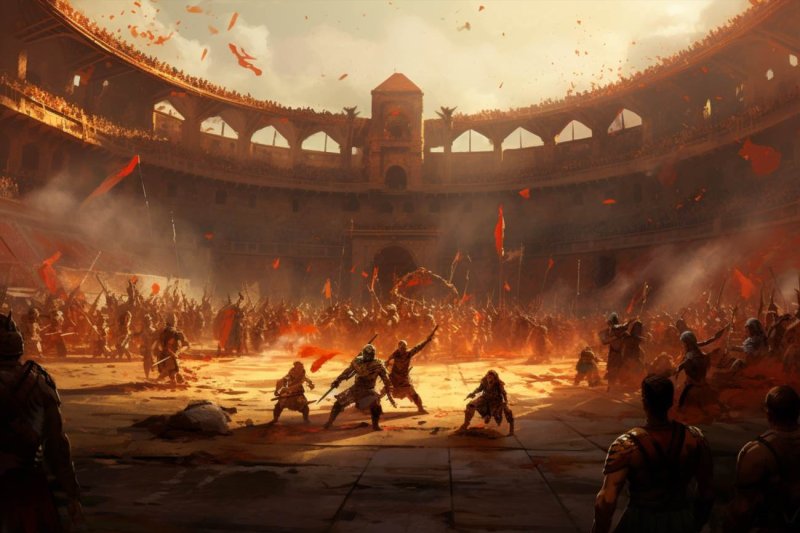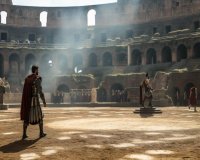Roman Gladiatorial School: A 2-Hour Insight

Roman Gladiatorial School: A 2-Hour Insight into Ancient Rome
Step back in time and immerse yourself in the world of ancient Rome with a fascinating two-hour exploration of Roman Gladiatorial Schools. These institutions played a pivotal role in shaping the culture and entertainment of the Roman Empire, showcasing the brutality and grandeur that defined this era.
Understanding the Gladiatorial Schools
Gladiatorial schools, known as "ludi," were training grounds for gladiators, the iconic warriors of ancient Rome. These schools were spread throughout the Roman Empire, with notable ones in Rome itself. Gladiators were skilled combatants who fought in arenas for the entertainment of the masses.
The Training Regimen
Life in a gladiatorial school was demanding and rigorous. Gladiators underwent intense physical training, including combat drills, weapon mastery, and endurance exercises. The objective was to mold them into formidable fighters capable of facing various opponents in the arena.
Types of Gladiators
There were several types of gladiators, each with its own distinct weaponry and fighting style. These included the heavily armed Samnites, the nimble Thracians, and the iconic Retiarii with their net and trident. The variety added a layer of excitement to the gladiatorial games, keeping the audience on the edge of their seats.
Gladiatorial Games and Spectacle
The gladiatorial games were a spectacle that captivated Roman society. These events were held in grand amphitheaters, such as the famous Colosseum. Gladiators fought to the cheers and jeers of the crowd, and the outcome of a battle could be a matter of life or death for the combatants.
The Legacy of Gladiatorial Combat
The gladiatorial schools and the games themselves left an indelible mark on Roman culture. They reflected the values of the society, blending violence with a sense of spectacle. The games served as a means of social control, distracting the populace from political unrest and discontent.
Conclusion
Exploring the world of Roman Gladiatorial Schools provides a captivating glimpse into the harsh yet intriguing aspects of ancient Roman life. The training, the fights, and the cultural impact of gladiatorial combat continue to fascinate historians and enthusiasts alike, offering a window into a bygone era.
Rome: Gladiator Show and Museum Tickets
Transport yourself back in time with an authentic demonstration of a gladiator fight in a unique location in Rome. Surrounded by music, lights, and visual effects, immerse yourself in Roman history.
About this ticket
Free cancellationCancel up to 24 hours in advance for a full refundReserve now & pay laterKeep your travel plans flexible — book your spot and pay nothing today.Duration 1.5 hoursCheck availability to see starting times.Wheelchair accessible
Experience Highlights
Ancient Atmosphere, Real Roman Life, Originality
Full description
GLADIATOR SHOW OF ANCIENT ROMEThe event takes place in the headquarters of Gladiators, in an equipped Arena, only at 3,5 Km. from Colosseum. In a striking environment with music, lights and effects, you can attend a Gladiators Fight, Ancient Dances, Vestals Rites and Pantomime. Important: The show is realized by historical reenactors with real weapons and armours.
The History and Significance of Roman Gladiatorial Schools in Rome
The Roman gladiatorial schools hold a significant place in the history of ancient Rome, offering a fascinating glimpse into the brutal yet captivating world of gladiators. These schools were integral to the Roman Empire and played a crucial role in both entertainment and politics. In this article, we will delve into the history and significance of Roman gladiatorial schools in Rome.
Origins of Gladiatorial Combat
Gladiatorial combat in Rome dates back to the early Roman Republic, around the 3rd century BC. It is believed to have originated as a form of funeral ritual. Friends and relatives of deceased individuals would host gladiatorial games in their honor, with slaves or prisoners of war initially forced to participate. Over time, these contests evolved into a full-fledged form of entertainment.
The first official gladiatorial contest was organized by the Roman general Decimus Junius Brutus in 264 BC, during his father's funeral. This marked the beginning of a tradition that would grow into a colossal spectacle.
Establishment of Gladiatorial Schools
To ensure a steady supply of gladiators, the Romans established specialized training schools. These schools, known as 'ludi,' were responsible for training and conditioning gladiators. The ludi were privately owned and operated for profit, reflecting the commercialization of the gladiatorial games.
Gladiatorial schools were equipped with training grounds, living quarters, and facilities for weapons training. Experienced trainers, often retired gladiators themselves, supervised the rigorous training routines. Gladiator recruits, known as 'auctorati,' were typically slaves, prisoners of war, or volunteers seeking fame and fortune in the arena.
Training and Discipline
Training in gladiatorial schools was harsh and demanding. Recruits endured grueling physical conditioning and combat drills to hone their combat skills. They were taught to use various weapons such as swords, tridents, and nets, depending on their chosen style. The most famous types of gladiators included the heavily armed 'murmillones' and the lightly armed 'retiarii.'
Discipline in these schools was strict, with severe punishments for disobedience. The life of a gladiator was one of constant hardship, but success in the arena could bring riches, fame, and even freedom. Many gladiators became celebrities in their own right, with fan followings and endorsements.
Significance of Gladiatorial Schools
The gladiatorial schools served a dual purpose in ancient Rome. Firstly, they were a source of entertainment for the masses. Gladiatorial contests were held in grand amphitheaters such as the Colosseum, where thousands would gather to watch these brutal battles. The games were a reflection of Roman values, including courage and the acceptance of death.
Secondly, gladiatorial schools had political significance. Roman emperors and aristocrats often sponsored these schools to gain favor with the public. They used the games to distract and appease the populace, diverting their attention from social and political issues. Successful gladiators became symbols of imperial power and prestige.
Decline and End
Despite their popularity, gladiatorial contests began to decline in the 4th century AD, as the Christianization of the Roman Empire led to a decrease in public support for these brutal spectacles. The final gladiatorial games were held in 404 AD by the Emperor Honorius. This marked the end of an era that had spanned over six centuries.
In conclusion, Roman gladiatorial schools were a central component of ancient Roman culture, providing entertainment and serving political purposes. The gladiators who trained in these schools, although often slaves or prisoners, left an indelible mark on the history of Rome and continue to fascinate us with their stories of valor and sacrifice.
Rome: Colosseum, Arena, Roman Forum, and Palatine Hill Tour
Take a trip back in time as you visit the most iconic sites of Roman history. Enjoy skip-the-line tickets to the Colosseum, the reconstructed Arena Floor, and the Palatine Hill and Roman Forum ruins.
Highlights
Porta Libertina (death door for wounded or dead gladiators) which you enter through, Port Triumphalis (exit for the gladiators who won) straight ahead, Bird’s eye view into the hypogeum or underground, Reconstructed trap door in the arena (small wooden platform to the left)
Full description
The arena floor (Arena means sand in Latin) is where all the action took place. It was made of wood and covered with a layer of sand to absorb the blood that was shed by the gladiators, animals, and criminals. After centuries of usage, the floor was removed in the 6th century, announcing the end of the gladiator battles. In the 1990s, a section of the arena floor was reconstructed, giving visitors a better idea of what the Colosseum must have looked like. During the Gladiator games, the gladiators would enter the arena through the Gate of Life and exit that way – if they survived. Those who perished in battle would be removed from the stadium through the Gate of Death. On the Colosseum behind the scenes, step out onto the reconstructed arena floor. Get an amazing 360-degree view of the Colosseum, the reconstructed trap door used to bring animals or slaves onto the arena, and a close look at the complex underground systems of the Hypogeum that played such a key role in the daily events.
Includes
Skip the line tickets for Colosseo & Arena & Roman Forum & Palatine Hill, Live guided tour, Headsets to hear the tour guide clearly, Visit of the first and second floor of Colosseo and Arena and Roman Forum and Palatine Hill
Meeting point
Meet your guide with the sign Eternal City Tours
Important information
What to bring: Passport or ID card, Comfortable shoes. Know before you go: Please provide the ages for everyone in your group and full names.
From $99.17 per person
Training and Equipment of a Roman Gladiator in Ancient Rome
Gladiators were an integral part of Roman society, and their training and equipment were crucial aspects of their preparation for the brutal arena battles they would face. In ancient Rome, the life of a gladiator was both revered and harsh.
Training:
Gladiatorial training was rigorous and demanding. Aspiring gladiators, known as "novices" or "novicii," underwent intense physical training and combat drills under the supervision of experienced trainers. These trainers were often retired gladiators who passed on their knowledge and expertise.
The training regimen included practicing with weapons like swords, shields, tridents, and nets. Novices were taught various fighting techniques and strategies to enhance their combat skills and survivability in the arena. Physical conditioning was paramount, focusing on strength, agility, and endurance.
Equipment:
Gladiators had a distinct set of equipment that was designed to provide both protection and an efficient means to engage in combat. The type of equipment varied based on the gladiator's specific class and fighting style.
1. Helmet (Galea): A crucial piece of armor, the helmet protected the gladiator's head and face. It was often made of bronze or iron and had distinctive designs based on the gladiator's role.
2. Shield (Scutum): The scutum was a large rectangular shield made of wood and covered with leather. It offered excellent protection against attacks and was an essential defensive tool in the arena.
3. Body Armor: Gladiators wore different types of body armor, including tunics made of thick linen or leather. Some wore metal plates to protect vital areas like the chest and abdomen.
4. Sword (Gladius): The gladius was the primary weapon for most gladiators. It was a short, double-edged sword designed for close-quarter combat, known for its deadly efficiency in the arena.
5. Spear (Hasta) and Trident: These were used by specific types of gladiators, enabling them to engage opponents at a distance and deliver powerful thrusts.
6. Net (Retiarius): The retiarius gladiator used a weighted net to entangle and incapacitate opponents, often paired with a trident for a lethal combination.
7. Greaves and Leg Guards: Gladiators wore protective coverings for their legs, such as greaves and leg guards, to shield against attacks and injuries.
In conclusion, the training and equipment of a Roman gladiator were carefully crafted to prepare individuals for the challenging and dangerous life they led. The combination of intense training and specialized weaponry defined the gladiator's ability to survive and excel in the arena, showcasing their skill and bravery to the spectators of ancient Rome.



